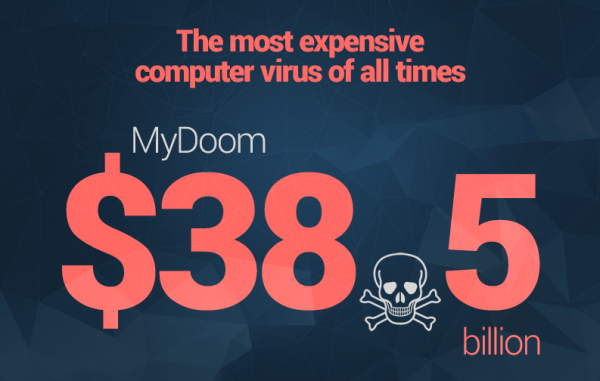The most expensive virus in the world in terms of monetary damage was MyDoom. MyDoom did an estimated $38.5 billion USD in economic damage.MyDoom came in January of 2006, and as of January 2004, it was the fastest spreading virus ever created. MyDoom is believed to have originated in Russia, but the author is still unknown.
It’s believed that MyDoom is a variant of MiMail. Mainly transmitted by e-mail, appearing as an error similar to what a user would get if their mail failed to send.
The user would unwittingly open the attachment in the e-mail and the worm would re-send itself to every address it could find.
The original version contained a payload that did two things: it opened a backdoor into your computer, allowing remote control of your computer, the other, was to perpetrate a DDOS(Direct Denial Of Service) against SCO group’s website.
The other version, MyDoom.B along with the above payload, also contained malicious software that blocked access to Microsoft and Antivirus websites to prevent the user from attempting to remove the virus.
To this Day, MDdoom is still in an active state, re-appearing in 2005 and recently in the 2009 DDOS attacks in South Korea and the United States.
#2. SoBig ($37.1 Billion)
In August of 2003, SoBig appeared, infections millions of computers across the world. SoBig evolved several times, making it hard to catch.
It is a worm that replicates itself, but also is a Trojan, as it disguises itself as something other than malware. It caused an estimated $37.1 billion dollars worth of damage across the globe.
The SoBig viruses infected a host computer via e-mail attachment, using their own SMTP agent to gather e-mail addresses and spread itself.
It was programmed to contact several IP addresses on August 26th 2003 and update itself. There is no clear reason why it was created. And, it even deactivated after only a month of operation. Its author is still unknown.
#3. ILOVEYOU ($15 Billion)
In 2000, ILOVEYOU, also known as the “Love Bug,” exploited human nature by disguising itself as a love letter and tricking recipients into opening it. It was only a matter of hours before computer systems across the world were tied up by this virus.
It has stunned experts with its fast and wide reach. Similar to the Melissa Worm in 1999, ILOVEYOU spread via e-mail with the subject line I Love You, and when the user opened the attached file, it sent copies of itself to the user’s entire address book.
#4. Conficker ($9.1 Billion)
#5. Code Red ($2 Billion)







